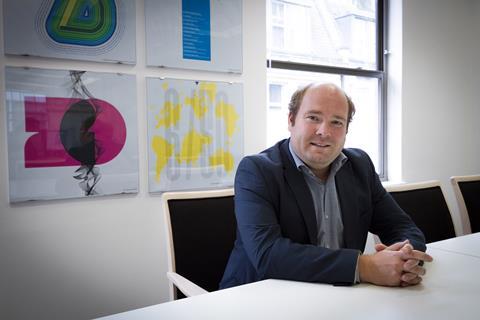Smaller, more efficient and cost-effective specialised hospital buildings designed to communicate with each other by being data-led and seamlessly connected will lead to better and faster patient care, writes Moritz Spellenberg, associate director at Llewelyn Davies

While the pandemic accelerated digital adoption to enable continuity of vital healthcare services, it also shed light on the shortcomings in existing systems and the need to ramp up digitalisation to ensure a future-proof industry and address key challenges.
The NHS is under tremendous pressure, with waiting lists and backlogs longer than ever, not enough beds and acute staff shortages. NHS Digital reveals that vacancy rates for nursing staff rose from 10.5% in 2021 to nearly 12% in 2022, with no end in sight to the trend.
Meanwhile, under the ambitious New Hospitals Programme, the government has committed to delivering up to 48 new hospitals nationwide by 2030, but the well-documented delays and funding problems have demonstrated that the only way to speed up delivery of high-quality hospitals is to rethink the traditional approach.
>> Also read: Rebooting the new hospital programme: is this the solution to the NHS backlog?
“Smart” hospitals can harness digital technologies to bring tangible solutions to some of the above issues and more, but their delivery requires a transformation in how we design and build facilities. According to the Department of Health and Social Care, our healthcare infrastructure needs to look beyond bricks and mortar to bring greater value to the public, and this means embedding data and digital technology by design.
To get there, we can learn from other countries. The Llewelyn Davies team is working as healthcare consultant in the design and construction of three public hospitals in Greece – the SNF General Hospitals of Komotini and Sparta, and the SNF University Pediatric Hospital of Thessaloniki – which promise to revolutionise what cutting-edge digitally-enabled hospitals can look like. They are setting a new benchmark for healthcare not only in Greece but much farther afield.
Funded by the Stavros Niarchos Foundation’s (SNF) $750m health initiative and brought to life by Renzo Piano Building Workshop, the projects offer a real template for future hospitals, which could be replicated to help deliver the UK’s hospitals programme.
Technology is at the heart of plans for the three hospitals which, along with incorporating the highest sustainability credentials through the use of renewable energy (and being paperless) are also emerging as game-changers in terms of their inbuilt digital capabilities. The goal is for them to transition to fully electronic records, aiming for HIMSS (healthcare information and management systems society) level 3 at launch and level 7 within several years.
Currently, there is no cohesive approach and every trust across the UK has its own digital strategy
Hospitals that attain level 7 are fully data-led and paper-free. In the UK, only a few have achieved this level, most notably Great Ormond Street Hospital for Children and the Royal Free NHS Foundation Trust’s Chase Farm Hospital in London, and the Alder Hey Children’s NHS Foundation Trust in Liverpool.
The problem is that, currently, there is no cohesive approach and every trust across the UK has its own digital strategy. Thankfully, the need for a more defined digital transformation plan is rising up the list of priorities.
In a 2022 policy paper outlining the government’s vision for health and social care, the secretary of state stressed the need to prepare the NHS to meet the challenges of 2048 – not 1948, when it was launched – noting that “[the] long-term sustainability of health and social care is dependent on having the right digital foundations in place”.
What does this mean for architects and designers?
The truth is that we are still building hospitals based on far outdated approaches to planning. Despite huge advances in technology, in order to start applying this successfully to solve existing challenges, the first step is to change mindsets and inspire clients and project teams to think innovatively and make new choices that they may have been cautious about previously.
For example, reducing physical consulting rooms by including booths for virtual consultations. As a very rough estimate, the initial outlay for future-ready digital systems can be around 10% of the entire construction cost of the building, a considerable investment that clients need to be prepared to take on board and communicate to health planners from the outset.
As architects, we also need to ensure that the functional brief is created in collaboration with a consultant who has in-depth expertise on digital technology. For SNF, we are working with HCI Group and Lexica on the roadmap to ultimately digitise all clinical services at the hospitals.
We need more specialised, smaller, more efficient and cost-effective hospital buildings that are designed to communicate with each other
By leaning on cloud, AI and machine learning technology to optimise efficiencies at the back end, hospitals can makes patient records easier to access and analyse. This can also eliminate data silos and automate many burdensome administrative processes, so that staff can be freed up to focus on their primary objective – patient care.
Similarly, hospitals can integrate IoT and introduce sensors measuring how much of the time a room is occupied – intelligence that can then be used to boost scheduling efficiencies.
We need more specialised, smaller, more efficient and cost-effective hospital buildings that are designed to communicate with each other by being data-led and seamlessly connected to provide better and faster care. This can have a positive impact on shortening waiting lists and reducing patient stays in hospital.
With the right strategy and collaborative efforts from design stage, embedding digital technologies can lead to smarter hospitals and offer many new opportunities to solve some of the sector’s most pressing issues both today and tomorrow.
Moritz Spellenberg is associate director at Llewelyn Davies

























No comments yet